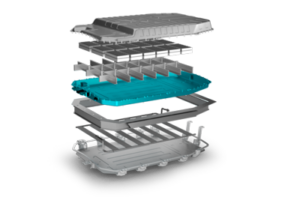Datwyler expands material capabilities to support industry shift to e-mobility
Schattdorf, Switzerland – Datwyler is expanding its in-house capabilities through a focus on Electrically and Thermally Conductive and Electromagnetic Interference (EMI) Shielding Materials (ETEMI™). Project ETEMI™ was launched in 2020 to address challenges in applications related to new mobility and beyond, with a material development scope covering conventional elastomers, liquid silicon rubber (LSR) and thermoplastics. The aim is to ensure that customers diversifying towards hybrid and battery electric vehicles are able to realize the full potential of system critical sealing components with enhanced functionality – such as sensing seal integrity or keeping electrical charge locally in a battery gasket, for example.
Luana Lettieri, Manager Material Development at Datwyler, commented: “As the trend towards electrification continues to gather momentum, the ability to conduct electricity and heat, as well as to shield certain components from electromagnetic signals, is increasingly important. Project ETEMI™ is the driving force behind the creation of an entirely new category of materials – those designed to fulfil the highest requirements in terms of sealing technology, in addition to delivering the aforementioned capabilities in a safe and efficient manner.”
Ultimately, ETEMI™ will be the catalyst for the creation of a material matrix whereby electrical and thermal conductivity and EMI shielding can be coupled and decoupled to suit a wide variety of applications. The thermal management of an electric vehicle battery could be managed in part by its sealing material, for example, while EMI shielding could likewise be introduced via sealing technology to safeguard components such as sensors and critical control units from environmental effects as well as electromagnetic interference.
Electrical conductivity for discharging and antistatic materials is also possible via sealing technology, and there are many examples of this combined functionality enabling certain components to be removed – such as metal conductors – thus delivering weight reduction benefits. Overall, the key objective is to balance the ability to provide a high-performance seal with the need to meet the many additional requirements arising from electrification.
The ETEMI™ project has seen Datwyler’s capabilities advance in a number of areas, including the mixing of specialist compounds using in-house mixing equipment and specifically designed mixing programs, and also the ability to comprehensively analyze and test new materials. Many of the challenges presented to the company as electrification projects develop will not have been experienced before, and new materials in this space must comply with regulations that are more stringent than ever before. As a result, in-house laboratories have been equipped with the expertise and technology required to develop and test compounds to the very highest levels of regulated norms, such as ISO 1853 and ASTM D911 for electrical conductivity, ASTM D4935-18 to analyze EMI shielding effectiveness or DIN EN 993-15 to characterize thermal conductivity of developed compounds.

